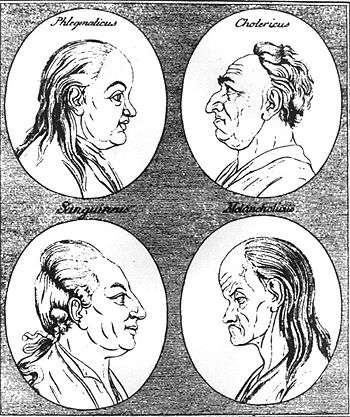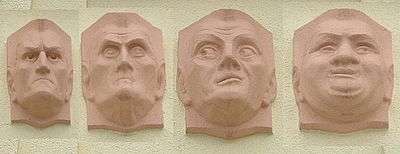Four temperaments

Phlegmatic and choleric (above)
Sanguine and melancholic (below)
Four temperaments is a proto-psychological theory that suggests that there are four fundamental personality types, sanguine (optimistic, active and social), choleric (short-tempered, fast or irritable), melancholic (analytical,wise and quiet), and phlegmatic (relaxed and peaceful). Most formulations include the possibility of mixtures of the types.
The Greek physician Hippocrates (c. 460 – c. 370 BC) incorporated the four temperaments into his medical theories as part of the ancient medical concept of humorism, that four bodily fluids affect human personality traits and behaviors. Later discoveries in biochemistry have led modern medicine science to reject the theory of the four temperaments, although some personality type systems of varying scientific acceptance continue to use four or more categories of a similar nature.
History and development
Temperament theory has its roots in the ancient four humors theory. It may have origins in ancient Egypt[2] or Mesopotamia,[3] but it was the Greek physician Hippocrates (460–370 BC) who developed it into a medical theory. He believed certain human moods, emotions and behaviors were caused by an excess or lack of body fluids (called "humors"): blood, yellow bile, black bile, and phlegm. Next, Galen (AD 129 – c. 200) developed the first typology of temperament in his dissertation De temperamentis, and searched for physiological reasons for different behaviors in humans. He classified them as hot/cold and dry/wet taken from the four elements.[4] There could also be "balance" between the qualities, yielding a total of nine temperaments. The word "temperament" itself comes from Latin "temperare", "to mix". In the ideal personality, the complementary characteristics or warm-cool and dry-moist were exquisitely balanced. In four less ideal types, one of the four qualities was dominant over all the others. In the remaining four types, one pair of qualities dominated the complementary pair; for example, warm and moist dominated cool and dry. These latter four were the temperamental categories Galen named "sanguine", "choleric", "melancholic" and "phlegmatic" after the bodily humors, respectively. Each was the result of an excess of one of the humors that produced, in turn, the imbalance in paired qualities.[5][6][7]

In his Canon of Medicine (a standard medical text at many medieval universities), Persian polymath Avicenna (980–1037 AD) extended the theory of temperaments to encompass "emotional aspects, mental capacity, moral attitudes, self-awareness, movements and dreams."[8]
Nicholas Culpeper (1616–1654), described the humours as acting as governing principles in bodily health, with astrological correspondences,[9] and explained their influence upon physiognomy and personality.[10] Culpeper proposed that, while some people had a single temperament, others had an admixture of two, a primary and secondary temperament.[11] Immanuel Kant (1724–1804), Rudolf Steiner (1861–1925), Alfred Adler (1879–1937), Erich Adickes (1866–1925), Eduard Spranger (1914), Ernst Kretschmer (1920), and Erich Fromm (1947) all theorized on the four temperaments (with different names) and greatly shaped our modern theories of temperament. Hans Eysenck (1916–1997) was one of the first psychologists to analyze personality differences using a psycho-statistical method (factor analysis), and his research led him to believe that temperament is biologically based. The factors he proposed in his book Dimensions of Personality were Neuroticism (N), the tendency to experience negative emotions, and Extraversion (E), the tendency to enjoy positive events, especially social ones. By pairing the two dimensions, Eysenck noted how the results were similar to the four ancient temperaments.
Other researchers developed similar systems, many of which did not use the ancient temperament names, and several paired extroversion with a different factor, which would determine relationship/task-orientation. Examples are DiSC assessment, social styles, and a theory that adds a fifth temperament. One of the most popular today is the Keirsey Temperament Sorter, whose four temperaments were based largely on the Greek gods Apollo, Dionysus, Epimetheus and Prometheus, and were mapped to the 16 types of the Myers–Briggs Type Indicator (MBTI). They were renamed as Artisan (SP), Guardian (SJ), Idealist (NF), and Rational (NT). Rather than using extroversion and introversion (E/I) and task/people focus, like other theories, KTS mapped the temperaments to "Sensing" and "Intuition" (S/N, renamed "concrete" and "abstract") with a new pair category, "cooperative" and "pragmatic" . When "Role-Informative" and "Role-Directive" (corresponding to orientation to people or to task), and finally E/I are factored in, the 16 types are attained. Finally, the Interaction Styles of Linda V. Berens combines Directing and Informing with E/I to form another group of "styles" which greatly resemble the ancient temperaments, and these are mapped together with the Keirsey Temperaments onto the 16 types.
Modern medical science has rejected the theories of the four temperaments, though their use persists as a metaphor within certain psychological fields.[12]
| Classical | Element | Adler[13] |
|---|---|---|
| Melancholic | Earth | Avoiding |
| Phlegmatic | Water | Getting |
| Sanguine | Air | Socially useful |
| Choleric | Fire | Ruling |
The four temperament types

Each of the four types of humors corresponded in ancient times to a different personality type. These were associated with a domination of various biological functions. Lievegoed suggested that the temperaments come to clearest manifestation in childhood, between approximately 6 and 14 years of age, after which they become subordinate (though still influential) factors in personality.[14]
Sanguine
The sanguine temperament is traditionally associated with air. People with this temperament tend to be lively, sociable, carefree, talkative, and pleasure-seeking. They may be warm-hearted and optimistic. They can make new friends easily, be imaginative and artistic, and often have many ideas.[15][16] They can be flighty and changeable; thus sanguine personalities may struggle with following tasks all the way through and be chronically late or forgetful.[17]
Pedagogically, they can be best reached through awakening their love for a subject and admiration of people.[17]
Choleric
The choleric temperament is traditionally associated with fire. People with this temperament tend to be egocentric and extroverted. They may be excitable, impulsive, and restless, with reserves of aggression, energy, and/or passion, and try to instill that in others. [15][16]
They tend to be task-oriented people and are focused on getting a job done efficiently; their motto is usually "do it now." They can be ambitious, strong-willed and like to be in charge. They can show leadership, are good at planning, and are often practical and solution-oriented.[15] They appreciate receiving respect and esteem for their work.[17]:20
Pedagogically, they can be best reached through mutual respect and appropriate challenges that recognize their capacities.[17]
Melancholic
The melancholic temperament is traditionally associated with the element of earth. People with this temperament may appear serious, introverted, cautious or even suspicious. They can become preoccupied with the tragedy and cruelty in the world and are susceptible to depression and moodiness. They may be focused and conscientious. They often prefer to do things themselves, both to meet their own standards and because they are not inherently sociable. [16][15]
Pedagogically, they can be best met by awakening their sympathy for others.[17]
Phlegmatic
The phlegmatic temperament is traditionally associated with water. People with this temperament may be inward and private, thoughtful, reasonable, calm, patient, caring, and tolerant. They tend to have a rich inner life, seek a quiet, peaceful atmosphere, and be content with themselves. They tend to be steadfast, consistent in their habits, and thus have steady and faithful friends.[15][16]
Pedagogically, their interest is often awakened by experiencing others' interest in a subject.[17]
People of this temperament may appear somewhat ponderous or clumsy. Their speech tends to be slow or appear hesitant.[15]
Decline in popularity
When the concept of the temperaments was on the wane, many critics dropped the phlegmatic, or defined it purely negatively, such as the German philosopher Immanuel Kant, as the absence of temperament. In the Five Temperaments theory, the classical Phlegmatic temperament is in fact deemed to be a neutral temperament, whereas the "relationship-oriented introvert" position traditionally held by the Phlegmatic is declared to be a new "fifth temperament."
Contemporary writings
In Waldorf education and anthroposophy, the temperaments are used to help understand personality. They are seen as avenues into teaching; as each child is considered to possess a unique blend of the four, they can be utilized to individualize the methods used with individual children and establishing a class balance, as well as to help with discipline.
Christian writer Tim LaHaye has attempted to repopularize the ancient temperaments through his books.[18][19][20]
Writer Florence Littauer describes the four personality types in her book Personality Plus.
See also Two-factor models of personality.
Cultural references
In 1946 George Balanchine choreographed a ballet he titled The Four Temperaments, set to music he commissioned from Paul Hindemith. The music, and thus the ballet, is in five parts: a theme and four variations titled Melancholic, Sanguine, Phlegmatic, and Choleric.
Émile Zola consciously employed the four temperaments in Thérèse Raquin.[21]
The Danish composer Carl Nielsen's Symphony #2 (1901-02), Op.16 entitled "The Four Temperaments" is structured upon the Four Temperaments.
Warhammer 40,000's Mournival employs the four temperaments to inspire each of the four member's personalities.
See also
- Fundamental Interpersonal Relations Orientation
- Enneagram of Personality
- Table of similar systems of comparison of temperaments
- Mindset Theory
- Myers-Briggs Type Indicator
- Keirsey Temperament Sorter
- Personality Plus
- Five Temperaments
- DISC assessment
References
- ↑ Woodcut from Johann Kaspar Lavater, Physiognomische Fragmente zur Beförderung der Menschenkenntnis und Menschenliebe (1775-1778)
- ↑ van Sertima, Ivan (1992). The Golden Age of the Moor. Transaction Publishers. p. 17. ISBN 1560005815.
- ↑ Sudhoff, Karl (1926). "Essays in the History of Medicine". Medical Life Press, New York: 67, 87, 104.
- ↑ Boeree, C. George. "Early Medicine and Physiology". Retrieved 21 February 2013.
- ↑ Kagan, Jerome (1998). Galen's Prophecy: Temperament In Human Nature. New York: Basic Books. ISBN 0465084052.
- ↑ Osborn L. Ac., David K. "INHERENT TEMPERAMENT". Retrieved 21 February 2013.
- ↑ http://sun2.science.wayne.edu/~tpartrid/Manuscripts/HEETemperament1.25.02.doc
- ↑ Lutz, Peter L. (2002). The Rise of Experimental Biology: An Illustrated History. Humana Press. p. 60. ISBN 0896038351.
- ↑ Nicholas Culpeper (1653) An Astrologo-Physical Discourse of the Human Virtues in the Body of Man, transcribed and annotated by Deborah Houlding. Skyscript, 2009 (retrieved 16 November 2011). Originally published in Culpeper's Complete Herbal (English Physician). London: Peter Cole, 1652.
- ↑ Nicholas Culpeper, Semeiotica Urania, or Astrological Judgement of Diseases. London: 1655. Reprint, Nottingham: Ascella, 1994.
- ↑ Greenbaum, Dorian Gieseler (2005). Temperament: Astrology's Forgotten Key. Wessex Astrologer. pp. 42, 91. ISBN 190240517X.
- ↑ Martindale, Anne E.; Martindale, Colin (1988). "Metaphorical equivalence of elements and temperaments: Empirical studies of Bachelard's theory of imagination". Journal of Personality and Social Psychology. 55 (5): 836. doi:10.1037/0022-3514.55.5.836.
- ↑ Lundin, Robert W. (1989). Alfred-Adler's Basic Concepts and Implications. Taylor and Francis. p. 54. ISBN 0-915202-83-2.
- ↑ Lievegoed, Bernard. Man on the Threshold. Hawthorn Press. pp. 80–81. ISBN 0950706264.
- 1 2 3 4 5 6 Childs, Gilbert (2009). Understand Your Temperament. Rudolf Steiner Press. ISBN 9781855840256.
- 1 2 3 4 Eysenck, Hans Jürgen (1967). The biological basis of personality. Thomas. pp. 35,39.
- 1 2 3 4 5 6 Steiner, Rudolf (2008). The Four Temperaments. Rudolf Steiner Press. ISBN 9781855842052.
- ↑ LaHaye, Tim (1966). The Spirit Controlled Temperament. Tyndale Publishing.
- ↑ LaHaye, Tim (1984). Your Temperament: Discover Its Potential. Tyndale Publishing. ISBN 0842362207.
- ↑ LaHaye, Tim. Why You Act the Way You Do. Tyndale Publishing. ISBN 0842382127.
- ↑ Zola, Preface to Thérèse Raquin.
Further reading
- Arikha, Noga (2007). Passions and Tempers: A History of the Humours
- Helminen, Päivi (1999). Discovering Our Potential: An Introduction to Character Types
- Rudolf Steiner (1909). The Four Temperaments
External links
- Four Temperaments Test, personality test.
- In Our Time (BBC Radio 4) episode on the four humours in MP3 format, 45 minutes
- John T. Cocoris, Psy.D. Description of the 4 Primary Temperaments at fourtemperament.com
- Descriptions of The Temperament Blends